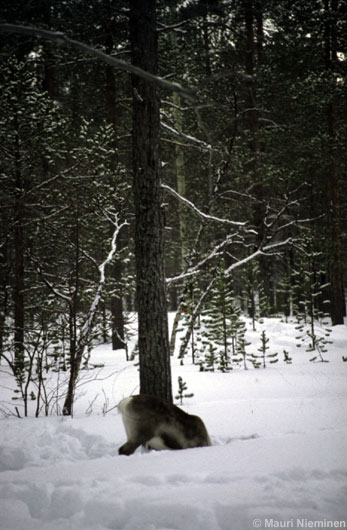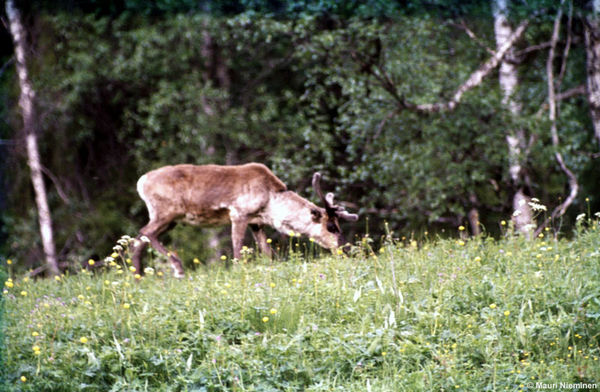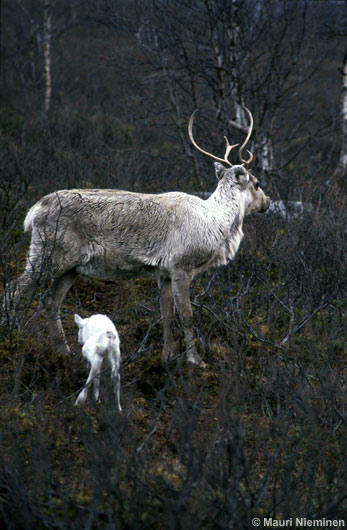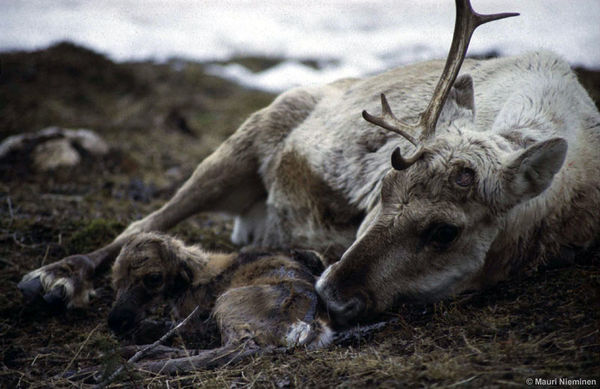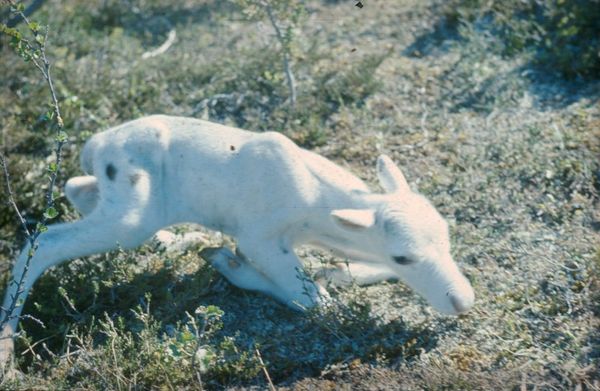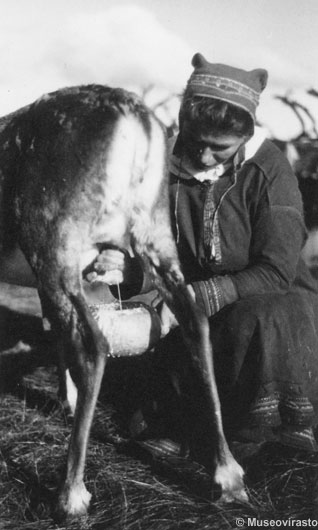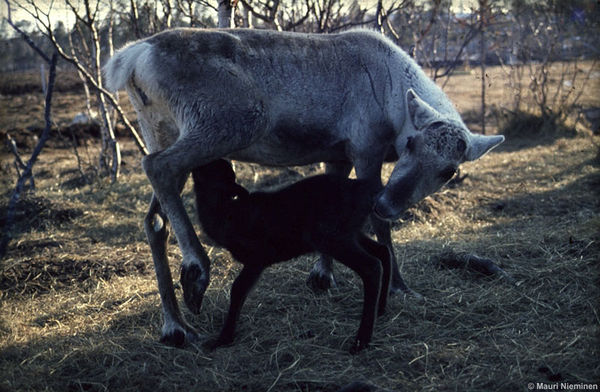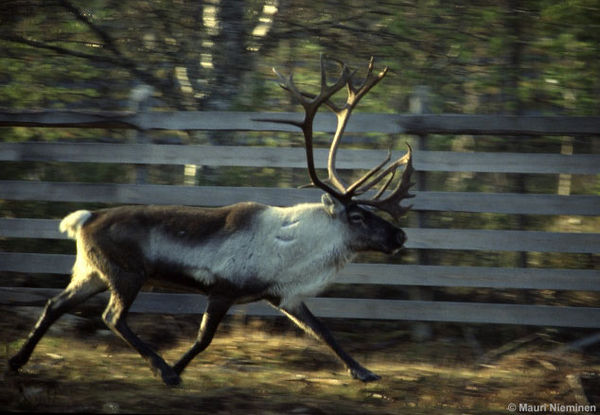Reindeer
Poro
Poro (tieteellinen nimi Rangifer tarandus tarandus L.) Poro on pitkäraajainen, nelivarpainen hirvieläin (Cervidae), kasvissyöjä ja märehtijä. Sen raajat päättyvät sorkkiin eli koparoihin. Koparan etuvarpaiden kynnet ovat pitkät, leveät ja kärjestään puolikuun muotoiset. Poron jälkikuvioissa erottuvat usein vain suurten etuvarpaiden kaviokynsien jäljet. Kulku lumessa on yleensä helppoa. Pehmeässä lumessa ja märillä soilla vaeltaessaan poro levittää lihasten avulla myös lisävarpaansa, jolloin jalkojen ns. pintapaine (paino/jalkapohjien pinta-ala) on porolla erittäin pieni, seistessä vain 85-102 g/cm2. Esimerkiksi ahmalla se on noin 50 g/cm2 ja sudella 90-110 g/cm2. Juostessa porollakin pintapaine voi olla 350-400 g/cm2.
Vaikka poro on alkujaan tuntureiden asukas, elää suurin osa Suomen poroista koko vuoden oudassa eli metsäalueella. Poro on varsin kinofiilinen eli hyvin lumeensopeutunut eläin. Metsä- ja tunturialueen rajamailla se kaivaa jäkälää vielä 70-90 cm paksussa ja pehmeässä lumessa.
Kevättalvella auringon kovettaessa hankia jäkälän kaivu käy talvilaitumilla vaikeaksi. Porot aloittavat tuolloin kevätvaelluksensa ja siirtyvät puilla kasvavien jäkälien,luppojen, syöntiin tai nousevat tuntureille. Laidunten kunnon huononnuttua poroja on jouduttu viime vuosina yhä enemmän myös ruokkimaan. Kesällä poron vaelluksia säätelee pyrkimys välttää kuumuutta ja sääskiä sekä löytää tuoreita, vasta kasvunsa alkuvaiheessa olevia ravintokasveja. Pohjoisessa porot nousevat kesäksi tuntureille. Metsä-Lapissa, missä tunturit ovat pieniä, porot hakeutuvat kesällä reheville avosoille.
Poro on hirvieläimistä sosiaalisimpia. Molemmilla sukupuolilla on normaalisti vuosittain vaihtuvat täyteissarvet. Sarvetonta poroa sanotaan nulpoksi. Poron sarvet kasvavat vuosittain pääkallossa olevien sarvianturoiden jatkeena. Vasoilla sarvet alkavat kasvaa jo ensimmäisten elinviikkojen aikana, ja syksyllä niillä on tavallisesti 10-20 cm pitkät, lähes haarattomat sarvipiikit. Ensimmäisenä syksynä voi vasoilla olla silti joskus jopa nelihaaraiset sarvet.
Täysikasvuisilla yksilöillä sarvet ovat yleensä haaroittuneet ja niiden otsahaarat ovat kaksi- tai useampihaaraiset ja latvaosastaan usein litteät. Iän myötä sarvien koko ja piikkien lukumäärä aluksi kasvaa, mutta silti sarvipiikkien lukumäärän perusteella poron ikä voidaan määrittää vain karkeasti. Saman yksilön sarvet muistuttavat kuitenkin vuosi vuoden jälkeen toisiaan. Vanhoilla ja huonokuntoisilla poroilla sarvien koko pienenee. Tunturialueella porojen sarvet ovat leveät ja yleensä väriltään vaaleat. Metsäalueella elävän poron sarvet ovat tavallisesti ruskeat.
Porolla sarvien kasvu on poikkeavaa ja erittäin nopeaa luun kasvua. Parhaimmillaan kesällä sarvet kasvavat samettimaisen nahan suojassa jopa 1-2 cm vuorokaudessa. Sarvien kasvua säätelevät monet hormonit, lähinnä sukupuolihormonit. Kuohituilla porohärillä lähinnä testosteronin puutteesta johtuen sarvien luutuminen hidastuukin ja pudottaminen viivästyy. Sarvet liittyvät porohirvailla urosten väliseen kilpailuun, ja ne toimivat tunnistamismerkkeinä ja "statussymboleina" syksyn kiima-aikana. Sarvet vaikuttavat myös lisääntymisen onnistumiseen, ja ne ovat kehittyneet täydentämään eläinten sukupuolitoimintoja. Hirvaiden välisillä tappeluilla ja sarvien "kalisteluilla" syksyllä on tärkeä poronaaraiden eli vaadinten kiimaa, ja samalla myös keväistä vasontaa, yhdenaikaistava ja lyhentävä vaikutus. Pohjoisissa oloissa on tärkeää, että vasat syntyvät parhaana mahdollisena ajankohtana keväällä.
Porolla sarvekkuus on talven vaikeissa lumioloissa myös naaraita, ja varsinkin kantavia vaatimia suosiva ominaisuus. Porohirvaat pudottavat sarvensa jo talvella ja ei-kantavat vaatimet eli runot varhain keväällä. Vasoilla ja aikuisista poroista vain kantavilla vaatimilla on sarvet vuoden kriittisimpänä ajankohtana huhti-toukokuussa. Ne ovat tällöin korkeimmalla arvoasteikossa ja pystyvät turvaamaan itselleen ja nopeasti painoaan lisäävälle sikiölle riittävän ravinnon. Kantavat vaatimet pudottavat sarvensa tavallisesti vasta vasonnan jälkeen ja aloittavat uusien kasvattamisen alkukesän hyvissä ravinto-oloissa. Tarharuokinnassa voi hyväkuntoinen kantava vaadin pudottaa sarvensa tosin joskus myös ennen vasontaa. Vaadinten sarvekkuus liittyy siten myös kuntoon ja ravinnon saantiin. Sarvien katkaisu pudottaa vaatimen ja myös hirvaan alemmaksi lauman yksilöiden välisessä arvoasteikossa.
Poron pää on suhteellisen pieni, ja sierainten välinen alue on kokonaan karvan peitossa. Silmät ja korvat ovat suuret, huulet melko liikkuvat. Poron koko vaihtelee hieman eri puolilla poronhoitoaluetta. Aikuisten vaadinten elopaino ontavallisesti 60-100 kilon, hirvaiden ja kuohittujen härkien 90-180 kilon välillä. Ruumiin pituus hännästä (saparosta) turvan kärkeen on porolla 150-210 cm, selän pituus 85-100 cm, hartia- eli säkäkorkeus 90-120 cm ja etujalan pituus 55-65 cm.
Vastasyntynyt poronvasa painaa touko-kesäkuussa keskimäärin 4-6 kiloa. Sen, kuten myös aikuisen poron, turkin väri voi vaihdella valkoisesta lähes mustaan. Noin puolet poroista on "tavallisen" värisiä, kolmannes näistä hieman vaaleampia tai tummempia. Hyvin vaaleita tai tummia poroja on usein vain 7-8 % laumasta. Kesällä aikuinen poro on väriltään tumman harmaanruskea. Kaulan sivut sekä varsinkin hirvailla selvästi erottuva kurkkuparta ja pitkin molempia kylkiä kulkevat lautumat ovat talvella vaaleahkot. Poron vatsa, reiden sisä- ja takasivut sekä suurinosa häntää ovat valkeat ja muodostavat selvästi erottuvan "peräpeilin".
Poron vanha talvikarva irtoaa kesällä ja alkaa kasvaa hyvin lämpöäeristäväksi talviturkiksi elokuussa. Täysikasvuisen poron karvapeite koostuu peitin- ja aluskarvoista. Peitinkarvat ovat tanakoita ja suoria ja ne sisältävät runsaasti lämpöä eristäviä ilmalokeroita. Aluskarva muodostaa talviturkissa tiheän pohjavillan ja estää ilman liikkumisen turkin sisällä. Karvapeitteen paksuus on 3-4 cm, ja selässä on keskimäärin 1 700 karvaa/cm2. Karvojen kohottaminen lisää, mutta tuuli ja sade heikentävät turkin lämmöneristystä. Kovassa tuulessa poro asettuu usein selin tuuleen suojatakseen päänsä, jossa on ohut karvapeite ja heikko lämmöneristys. Kylmyys ei ole kuitenkaan hyväkuntoiselle porolle ongelma, sillä se selviytyy yli 50oC:n pakkasessa kohottamatta lämmöntuottoaan. Poron jalkojen kylmänkestävyys on myös hyvä, ja verenkiertoa parantaa erikoistunut laskimo-valtimojärjestelmä ja jalkojen alaosan luuytimissä oleva öljyhappo (sulamispiste +15oC), joka toimii "pakkasnesteenä" pitäen jalat sulina kovillakin pakkasilla.
Poronvasa voi joutua syntymähetkellä alttiiksi suurille lämpötilan muutoksille, sillä esimerkiksi Siperiassa vasat syntyvät jopa 40oC:n pakkasiin. Vasonta-aika alkaa meillä huhtikuun lopulla ("vappuna vasa hangella") jatkuen normaalisti kesäkuun alkuun. Vasonnan huippu on Erkinpäivän tienoilla (18.5.), ja pääosa vasoista syntyy toukokuun aikana. Vasonta on yleensä porolla helppo ja kestää vain 20-30 minuuttia. Poronvasat ovatkin ns. pesäjättöisiä, sillä ne ovat hyvin kehittyneitä ja kykenevät pian seuraamaan emäänsä. Niiden turkki on kuivuttuaan hyvä lämmöneriste kovassakin pakkasessa. Tiheän turkin (keskimäärin 3 200 karvaa/cm2) kaikki karvat ovat onttoja. Vasan karvapeite alkaa uusiintua ja muuttua ns. purkakarvaksi noin kuukauden iässä kesäkuun lopulla. Loppusyksyllä vasan turkki vastaa rakenteeltaan aikuisen poron turkkia.
Poronvasan hyvä kylmänkestävyys vasonta-aikana johtuu turkin lisäksi myös ns. ruskeasta rasvasta, jota on runsaasti tärkeimpien sisäelinten, kuten munuaisten ja sydämen ympärillä, lapaluiden välissä, rintalastan alueella ja selkärangan molemmilla puolilla. Vasalla sitä on 1-2 % ruumiinpainosta, ja sen tehtävänä on tehokas lämmöntuotto. Ruskea rasva häviää 3-4 ensimmäisen viikon aikana. Kesällä kuumuus ja vertaimevät hyönteiset eli räkkä aiheuttavat poroille verenvähyyttä eli anemiaa ja vasakuolemia. Talviturkin säilyminen kesä-heinäkuulle ja toimivien hikirauhasten puuttuminen aiheuttaa kuumina päivinä stressiä myös aikuisille poroille. Rauhallisissa oloissa poro hengittää 8-14 kertaa minuutissa, mutta kuumuus ja rasitus lisäävät sydämen sykettä ja hengitysliikkeiden määrän jopa kymmenkertaiseksi. Poro laskee aivojen lämpötilaa pitäen "päänsä kylmänä" kesällä, mutta silti se kestää paremmin kylmää kuin kovin kuumaa säätä.
Luonnonoloissa poron ravinto koostuu yli 300 ravintokasvista. Poron kesäravinto on hyvin monipuolista ja ravitsevaa. Loppukesällä ja syksyllä porot syövät runsaasti sieniä. Talvella porot kaivavat lumen alta jäkälää, varpuja ja metsälauhaa. Kevättalvella porot syövät puilla kasvavia luppoja. Sopeutuminen ravinnon määrän ja laadun jyrkkiin vuodenaikaisvaihteluihin perustuu porolla koko ruuansulatuselimistön, ennen kaikkea pötsin eli rapamahan, toiminnan muutoksiin. Juuri pötsissä tapahtuvat muutokset ovat mahdollistaneet näinkin suuren kasvissyöjän selviytymisen alueella, jossa ravinnonsaanti on erittäin niukkaa ja ravinnon laatu suuren osan vuotta heikkoa. Vain lyhyen kesän aikana on saatavilla korkealuokkaisia ravintoaineita. Poron aineenvaihdunta vilkastuukin keväällä ja alkukesällä. Kesällä poro lisää nopeasti painoaan, korjaa talviset kudosvauriot ja uusii karvapeitteensä, tuottaa maitoa ja kasvattaa myös uudet sarvensa.
Poronmaito on erittäin ravitsevaa vasan ravintoa, vaikka maidontuotto alkaa jo varhain keväällä. Poron varsinainen maidontuottovaihe on lyhyt, mutta se vaatii runsaasti energiaa. Vaadin voi menettää imetysaikana viidenneksen painostaan, ja sillä saattaa esiintyä myös anemiaa. Poronmaidossa on rasvaa (yli 20 %), valkuaista (noin 10 %) ja kuiva-ainetta enemmän kuin muiden hirvieläinten maidossa. Maito sisältää runsaasti eri vitamiineja ja vastasyntyneelle vasalle tärkeitä tautien vasta-aineita. Maitosokeria eli laktoosia poronmaidossa on vähän. Poronmaidon rasvoissa voidaan erottaa 19-20 eri rasvahappoa, ja poronmaidossa on runsaasti tyydyttymättömiä rasvahappoja. Poronmaidon energiasisältö on 7-10 MJ litrassa, eli se on noin kolme kertaa korkeampi kuin lehmän maidossa. Vaadin tuottaa noin litran maitoa vuorokaudessa. Kilon suuruiseen painonlisäykseen poronvasa tarvitsee vain noin 3,4 litraa emän maitoa, mutta muilla hirvieläimillä ja kotieläimillä tähän kuluu jo 6-10 litraa.
Imetysten kestot vaihtelevat poronvasalla ensimmäisen elinviikon aikana muutamasta sekunnista aina 3-4 minuuttiin. Pidemmät imetykset koostuvat useasta peräkkäisestä jaksosta. Imetykset lyhenevät ja harvenevat nopeasti vasontaa seuraavan kuukauden aikana.
Normaalissa imetysasennossa emä nuolee vasan peräpäätä. Nuoleminen saa vasan virtsaamaan ja ulostamaan. Suurikokoisemmat urosvasat imevät 7-12 % enemmän kuin naarasvasat kolmen ensimmäisen elinviikon aikana. Kesällä vasojen paino lisääntyy jopa puoli kiloa vuorokaudessa.
Syksyyn mennessä saavutettu kunto ja ravintovarastot vaikuttavat ratkaisevasti porolla kiiman alkamiseen, tiinehtymiseen, sikiön kasvuun ja myös keväiseen vasontaan. Erittäin suotuisissa oloissa vasat voivat tulla kiimaan jo ensimmäisenä syksynä ja vasoa vuoden ikäisinä seuraavana keväänä. Uros- ja naarasporot ovat kuitenkin sukukypsiä usein vasta 1,5-vuotiaina ns. urakkoina ja vuoneloina. Naarasporo tulee kiimaan ja tavallisesti myös kantavaksi, kun sillä on runsaasti rasvavarastoja ja elopaino ylittää 60 kiloa. Hirvaita on porolaumassa tavallisesti 15-20 %. Syksyllä kiima-aikana hirvas kerää haaremiinsa 10-20 vaadinta.
Poron kiima eli rykimä on kiihkeimmillään lokakuun alussa ja se kestää noin kuukauden. Porolla lisääntyvä pimeähormonin eli melatoniinin eritys käpylisäkkeestä syksyllä ilmeisesti kiihdyttää sukupuolirauhasten toimintaa ja saa aikaan kiiman.
Hyväkuntoiset ja vanhemmat vaatimet ja hirvaat tulevat kiimaan tavallisesti ensimmäisinä. Porovaatimella voi olla 3-7 kiimaa sama syksynä. Huono kunto viivästyttää kiiman alkua ja estää myös uusintakiimat.Kantoaika porolla on keskimäärin 220 vuorokautta. Hyvässä lisääntymiskunnossa vaadin on tavallisesti 10-12 ikävuoteen ja hirvas 8-9 ikävuoteen saakka. Vaatimen paino nousee viiden vuoden ikään saakka. Tämän jälkeen paino pysyy lähes samana, ja 12-13 vuoden jälkeen se laskee selvästi. Vaatimet tuottavat hyväkuntoisia vasoja aina 9. vasomiskertaan saakka. Tämän jälkeen vasojen syntymäpainot alkavat laskea. Vaadin synnyttää keväisin tavallisesti vain yhden vasan. Vaatimet voivat saavuttaa 18-20 vuoden iän. Luonnonoloissa hirvaatkin voivat elää yli kymmenvuotiaiksi.
Talvella porojen kasvu lähes lakkaa, ja aktiivisuus ja ravinnonotto vähenevät hyvissäkin olosuhteissa. Koko aineenvaihdunta siirtyy alemmalle tasolle. Talvella mm. sydämentoiminta ja hengitys hidastuvat. Poronjäkälien (jäkälät)valkuaispitoisuudet ovat alhaiset, ja ne sisältävät myös vähän kivennäis- ja hivenaineita sekä vitamiineja. Jäkälien valkuaisaineet ovat heikosti sulavia,ja poro on talvella usein ns. negatiivisessa typpitaseessa ja laihtuu. Jäkälien kuitupitoisuudet ovat kuitenkin alhaiset, ja niissä on paljon helposti sulavia sokereita ja jäkälille tyypillisiä polysakkarideja. Jäkälistä poro saa talvella runsaasti energiaa. Luppojen valkuaispitoisuudet ovat yleensä korkeammat kuin poronjäkälien, ja ne ovat myös helpommin sulavia. Lupot ovat sopivaa ravintoa nälkiintyneille poroille kevättalvella.
Normaalitalvinakin poro menettää 20 % ja erittäin vaikeina talvina jopa 40 % syksyisestä painostaan. Rasvavarastot ovat porolle elintärkeät, sillä valtaosa talvisesta painonmenetyksestä kohdistuu juuri rasvoihin. Pitkä pakkaskausi kuluttaa nopeasti rasvoja ja paino laskee. Kun rasvat on kulutettu lähes loppuun,elimistö joutuu turvautumaan myös lihaksiston valkuaisaineisiin. Kulutus kohdistuu aluksi ruuansulatuskanavan proteiineihin, ja pitkä nälkiintymiskausi koettelee kovimmin vasoja ja nuoria poroja. Pötsin bakteeritoiminnan väheneminen ja vedenvaihdonhidastuminen säästävät energiaa talvella. Poron vuorokautinen vedenkulutus onkin tuolloin vain noin 1/3 kevään ja kesän huipusta. Vedenvaihdon hidastuminen johtuu vähentyneestä aineenvaihduntanopeudesta ja ravinnonotosta. Poro käyttää talvella uudelleen myös lähes 60 % virtsa-aineestaan eli ureasta valkuaisainetuotantoonsa. Jäkälien helposti sulavat sokerit mahdollistavat tämänkin toiminnan. Poron talviravinnon ydinongelmana ei olekaan usein ravinnon määrä, vaan energian saanti.
Paimennus / Herding
Poronhoito- / poro-aiheisia linkkejä: poronhoito - kokoomasivu
Reindeer
Reindeer, semi-domesticated (Rangifer tarandus tarandus L.). The reindeer is a ruminant herbivore. It is a long limbed, four-toed deer (Cervidae) whose legs end in hoofs. The nails of the front toes are long, wide and half-moon shaped. The tracks of the reindeer often only reveal the imprint of these toe nails as it moves easily over the snow. In soft snow and mashland, it spreads its extra toe, which means that the surface pressure (pressure/ surface area of the sole) is extremely low (only 85-102 g/cm2 for a standing animal) compared with that of a wolverine (50 g/cm2) or a wolf (90-110 g/cm2. When running, the surface pressure may rise to 350-400 g/cm2.
Although the reindeer originated on the fells, most of the animals in Finland live throughout the year in the forested area of Lapland. The reindeer is well adapted to living in the snow. In the border lands between the fells and the forests it can dig out moss from under soft snow that is up to 90 cm thick.
However, in late winter and early spring, when a hard crust is formed on the surface of the snow by alternating sun and frost, it becomes difficult for the reindeer to dig up moss on their winter grazing ranges, and they begin their spring migration and change over to eating horsehair lichen, which grows on trees, or they move up to the fells. With the deterioration in the pastures, in recent years it has become increasingly necessary to feed the reindeer with fodder. In summer their movements are determined by their efforts to escape from the heat and midges and to find fresh, still young vegetation. In Forest Lapland, where the fells are low, the reindeer move to the lush open bogs.
The reindeer is one of the most gregarious of the deer family. The antlers of both sexes are usually replaced annually. The antlers grow branches each year from the frontal bones in the skull. The antlers of the calves begin to grow during their first weeks of life, and by the autumn they usually have 10-20 cm-long almost unbranched tines. However, some calves may have even four-branched antlers in their first autumn.
Fully grown individuals usually have branched antlers, usually with two or more branches that are often flat at the crown. The size of the antler and the number of tines increases with age, but even so counting the tines only provides a rough indication of an animal s age. The two branches of the antlers of the same individual become increasingly similar year by year. In old and debilitated reindeer the size of the antlers decreases. In the fell regions, the antlers are wide and usually light in colour, whereas in the forests they are usually brown.
The growth of reindeer antlers represents an exceptionally fast rate of ossification. At its most rapid in the summer, the growth of the antlers under their velvety skin covering can be as rapid as 1 or 2 cm a day. The growth is regulated by various hormones, mainly sex hormones. The lack of testosterone in gelded reindeer causes the ossification to slow down, and dropping of the antlers is delayed. The antlers are important in competition between the male animals, and they serve as identifiers and status symbols during the rutting season in autumn. They are also important with regard to successful reproduction, and they have developed to enhance reproductive activities; the fights and clashing of antlers between the bulls in the autumn has a synchronizing and shortening effect on the females period of heat, and consequently on the calving in spring. In the harsh conditions of the north it is important that the calves should be born at the optimum time in the spring.
The antlers also have a beneficial effect on the females, especially when they are pregnant, in the difficult snow conditions of winter. The bulls drop their antlers in the winter, and the non-pregnant females early in the spring. Only the calves and the gravid females have antlers at the critical time in April and May. The latter animals now enjoy the highest status, and they can ensure sufficient nourishment for themselves and their fast-growing foetuses.
The pregnant cows usually only drop their antlers after calving and begin growing new ones in the good feeding conditions of early summer. In pen feeding, a healthy pregnant cow may sometimes drop her antlers before calving. The size of the antlers also depends on the condition of the animal and the availability of food. A broken antler means a lower status for a cow, and also for a bull, within the hierarchy of the herd.
The head of the reindeer is relatively small, and the area between the nostrils is completely covered with fur. The eyes and the ears are large and the lips fairly flexible. The reindeer varies in size somewhat according to the reindeer husbandry area. The live weight of cows is usually 60-100 kilos, that of bulls and bullocks 90-180 kilos. The length of the body from the tail to the muzzle is 150-210 cm, and the length of the back 85-100 cm; the height at the withers is 90-120 cm, and the length of the forelegs 55-65 cm.
A newborn calf weighs 4-6 kilos on average in late May and early June. The coat of a calf, like that of an adult reindeer, can vary from white to almost black. Most of the animals are of a common colour, but about a third are slightly lighter or darker. Usually only about 7-8% of the herd is made up of very light or dark individuals. An adult reindeer is dark greyish brown in colour in summer. The sides of the neck and particularly the conspicuous tuft at the throat of the male and the patches along both sides of the body become whitish in winter. The belly, the backs and sides of the haunches and most of the tail are light in colour and combine to create very distinctive hind quarters.
The thick heat-conserving winter coat of the reindeer is shed in summer and begins to grow again in August. The coat of a fully grown reindeer consists of outer bristles and an underfur. The outer bristles are thick and straight, and they form numerous air pockets which provide insulation and prevent the body heat from escaping. The underfur creates a thick pile for the winter coat and prevents the movement of air inside the coat. The coat is 3-4 cm thick, and on the back it has 1700 hairs per sq cm on average.
?? The raising of the pile increases, but the wind and rain impairs the insulating qualities of the coat. A reindeer usually stands with its back to a strong wind in order to protect its head, which has a thin coat with poor insulation. However, the cold does not present a problem for a healthy reindeer, which can survive in temperatures below -50ºC without increasing its production of heat energy. The legs of the reindeer are also able to withstand the cold well, and the blood circulation in them is improved by specialized system of veins and arteries and by the presence of oleic acid in the marrow of the lower legs. Oleic acid has a melting point of +15ºC and acts a kind of anti-freeze, keeping the legs unfrozen even in very cold temperatures.
A calf may be submitted to considerable fluctuations in temperature after birth; in Siberia, for example, the temperature may be -40ºC when a calf is born. In Finnish Lapland, calving begins at the end of April and usually continues into early June, peaking around 18 May, in which month most of the calves are born. Parturition is usually easy, lasting only 20-30 minutes. The calves are ??so-called nest-deserting animals; they are well developed, and they are soon able to follow their mothers. After it has dried, their coat provides good heat insulation even in cold temperatures. All the hairs of the thick coat (on average 3200 per sq cm) are hollow. The coat of a calf begins to renew itself and change into a specific hair called purkakarva after about one month at the end of June. By late autumn the calf s coat is similar to that of an adult reindeer in its structure.
In addition to its coat, the ability of a reindeer calf to withstand the cold is a result of brown fat, which it has in abundance around the most important inner organs (the kidneys and the heart), between the shoulder blades, in the vicinity of the breastbone and along both sides of the backbone. It constitutes 1-2% of the body weight of a calf, and its function is provide heat rapidly. The heat of summer and blood-sucking insects are a cause of anaemia and death among the calves. The conservation of the winter coat into June and July and the lack of sweat glands are also a cause of stress for adult reindeer when the weather is hot. When relaxed, a reindeer breathes 8-14 times a minute, but heat and stress can increase the heartbeat and breathing rate tenfold. A reindeer reduces the temperature of its brain to cool its head, but even so it can withstand the cold better than very hot weather.
In its natural habitat, the nourishment of the reindeer consists of more than 300 different plants. Its summer fare is very varied and nourishing.In late summer and autumn, reindeer eat a lot of fungi. In winter they dig up lichens, shoots and hair grass from under the snow. As winter turns to spring, they eat horsetail lichens from the trees. They adapt to the great fluctuations in the availability and quality of nourishment by means of changes in the way their whole digestive system, above all the rumen, functions. This has made it possible for such a large herbivore to survive in an area where sustenance is scarce and poor in quality for much of the year. Only during the short summer is high-quality food available, and in spring and early summer the metabolism of the reindeer becomes more active. In summer the weight of the animal increases, it repairs the damage to its tissues that it has sustained during the winter, it renews its coat, it produces milk and it grows new antlers.
The milk of the semi-domesticated reindeer provides very rich nourishment for the calves although the production of milk begins in early spring. The actual period of milk production is short, but it consumes a great amount of energy. A cow may lose a fifth of its weight during lactation, and it may suffer from anaemia. The milk of reindeer contains more fat (over 20%), proteins (about 10%) and solids that that of other deer. It is rich in a variety of vitamins and antibodies, which are important for newborn calves. There is little lactose in reindeer milk. It is possible to distinguish 19 or 20 different fatty acids in it, many of which are unsaturated. The energy content of reindeer milk is 7 to 10 MJ a litre, in other words about three times as high as that of cow s milk. The female reindeer produces about a litre of milk a day. In order to increase its weight by one kilo, a calf needs only about 3.4 litres of its mother s milk, while other deer and domestic animals require 6 to 10 litres. The suckling time for a calf during its first week of life varies from a few seconds to three or four minutes. Longer periods of suckling consist of several consecutive intervals. The periods of suckling rapidly grow shorter and less frequent during the month after the birth.
In the normal suckling position, the cow licks the anus of the calf, which causes it to urinate and defecate. The bigger male calves consume 7-12% more milk than the females during the first three weeks of life. In summer, the weight of a calf may increase by half a kilo a day.
The physical condition that the reindeer has reached and the food reserves that it has managed to store up by the autumn have a crucial significance for oestruation, gestation, the growth of the foetus and also for the calving in the spring. In particularly favourable circumstances, the calves may begin to rut in their first autumn and to calve in the following spring when they are only one year old. Often, however, reindeer of both sexes do not become fertile until they are one and a half years old. The female comes into heat and usually also conceives when it has large stores of fat and its live weight exceeds 60 kilos. Males usually constitute 15-20% of the herd. In the rutting season in autumn, the male collects a harem of ten to twenty cows. The rutting season lasts for about a month, and it is at its most intense in early October. An increased secretion of melatonin by the pineal glandin autumn apparently stimulates gonadal function and oestruation.
It is usually the older healthy cows and bulls that begin to rut first. The female may be in heat three to seven times in the same season. Poor physical condition can delay oestruation and also prevent the cow from coming into heat again. The period of gestation for the reindeer is 220 days on average. A cow usually remains fertile until it is 10-12 years old and a bull till it reaches the age of eight or nine.
The female increases in weight until it is five years old, after which its weight remains almost constant until the age of twelve or thirteen, when it begins to fall noticeably. Cows can give birth to healthy calves up to nine times, but after this the weight of the calves begins to decrease. They usually give birth to only one calf each spring. They can live to an age of 18 20 years, while males in their natural habitat can live to be over ten years of age. In winter reindeer practically cease to grow, and their activity and food intake decrease even in good conditions. Their metabolism rate falls, and their heartbeat and breathing slow down. The protein content of reindeer moss is low, and it contains few minerals, trace elements and vitamins. The proteins it contains are difficult to digest, and in winter the reindeer has a negative nitrogen balance and grows thinner. However, the fibre contents of lichens are small, and they contain numerous easily digestible sugars and polysaccharides, which provide the reindeer with a lot of energy in wintertime. The protein content of horsetail-lichens is usually higher than that of reindeer moss, and the proteins are easier to digest. Horsetail-lichens prove a suitable source of nourishment for hungry reindeer in late winter and early spring.
In normal winters, the reindeer may lose 20% and in difficult winters up to 40% of its autumn weight. Reserves of fat are vital for the reindeer, because its loss of weight in winter is a result of the depletion of its body fats. A long period of freezing weather uses up the fats rapidly and the animal s weight drops sharply. When the fat has been almost exhausted, the body resorts to using muscle protein. Initially it is the proteins of the digestive tract that are consumed. A long period of hunger affects calves and young animals worst. A decrease in the bacterial activity of the rumen and a reduction in the intake and excretion of water help to conserve energy in the winter. The reindeer s consumption of water is then only about one third of its peak in spring and summer. The decrease in the consumption and excretion of water is a result of reduced metabolic activity and food intake. In winter, the reindeer uses nearly 60% of its urea for the production of proteins. This is made possible by the easily digestible sugars contained in lichens. In fact, the fundamental problem of nourishment for the reindeer in winter usually lies not so much in the amount of food available as in its ability to obtain energy.

